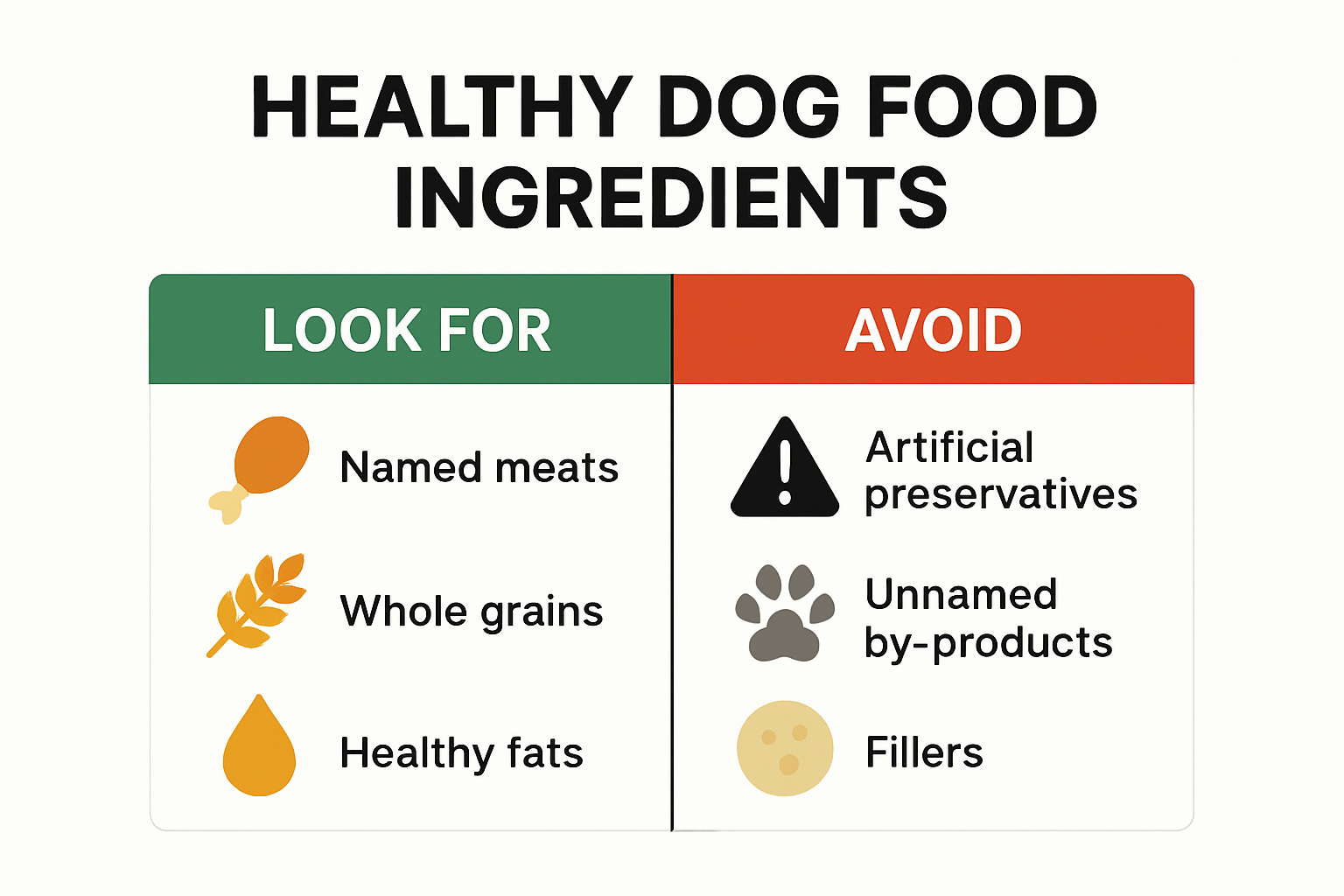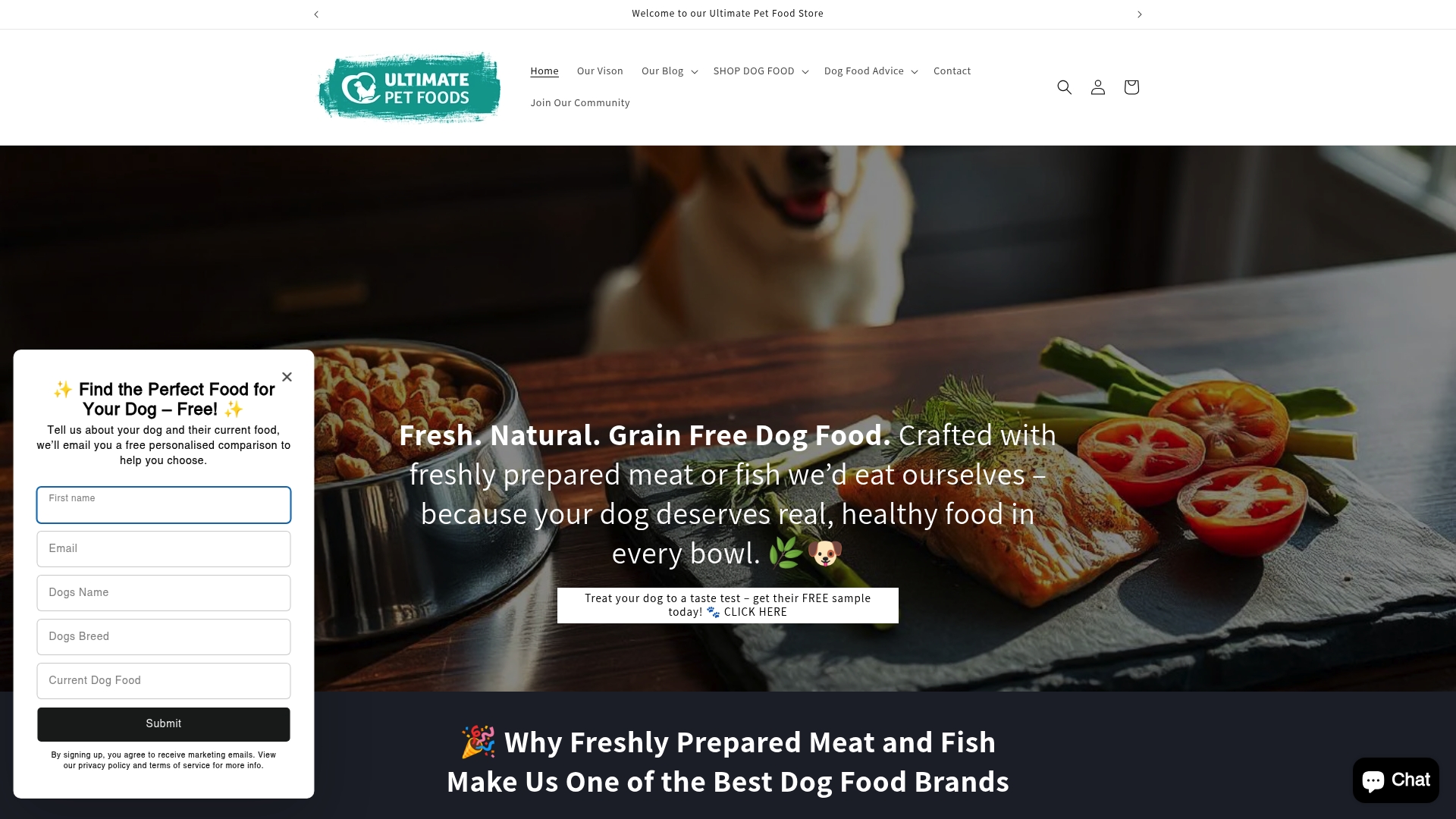
Decoding Your Dog Food Ingredient List for Better Nutrition
Share
Choosing what goes in your dog’s bowl can feel like a guessing game. Most people scoop out kibble without ever reading the label. But here is a surprise. Ingredients like artificial preservatives and unnamed meat meals can silently harm your dog’s health over time. The weird part is that the packaging rarely tells the whole truth about nutrition, yet a simple review of the ingredient list can reveal more than any slogan on the bag.
Table of Contents
- Step 1: Review Your Current Dog Food Options
- Step 2: Identify Key Ingredients To Look For
- Step 3: Evaluate Ingredients To Avoid
- Step 4: Compare Brands And Formulations
- Step 5: Consult With Your Veterinarian
Quick Summary
| Key Point | Explanation |
|---|---|
| 1. Review Current Dog Food Ingredients | Examine the ingredient list of your dog’s current food to identify any poor-quality components or allergens. |
| 2. Focus on High-Quality Protein Sources | Choose dog food with named proteins like chicken or lamb as the primary ingredients for optimal nutrition. |
| 3. Avoid Harmful Ingredients | Stay away from artificial preservatives, fillers, and unspecified meat by-products that could harm your dog’s health. |
| 4. Compare Dog Food Brands Systematically | Create a comparison chart to assess nutritional content across various brands and find the best fit for your dog. |
| 5. Consult Your Veterinarian for Guidance | Discuss your dog’s dietary needs with your veterinarian to ensure a balanced diet that caters to their specific health requirements. |
Step 1: Review Your Current Dog Food Options
Starting your journey to better dog nutrition begins with a critical examination of your current dog food. This step is about understanding exactly what you’re currently feeding your furry companion and identifying potential areas for improvement. Gathering your current dog food packaging is essential for a thorough ingredient list review.
First, locate the packaging of your dog’s current food. If you’ve discarded the original container, check for a label saved in your kitchen or retrieve details from the manufacturer’s website. The comprehensive guide to understanding pet nutrition can help you navigate this process more effectively.
As you review the ingredient list, focus on the order of ingredients. According to the American Kennel Club, ingredients are listed by weight, with the first few items representing the most significant components of the food. Look for high-quality protein sources like whole meats or meat meals as the primary ingredients. Avoid foods with excessive grain fillers, unspecified meat by-products, or artificial preservatives.
Pay special attention to the protein content and source. Quality proteins should be named specifically, such as “chicken” or “lamb” rather than generic terms like “meat meal” or “animal protein.” Check for any artificial colors, flavors, or unnecessary additives that might not contribute to your dog’s nutritional needs.
Take note of any specific observations about your current dog food:
- Ingredients you recognize and understand
- Protein sources and their quality
- Presence of artificial additives
- Overall nutritional balance
This initial review sets the foundation for making informed decisions about your dog’s nutrition. By understanding what’s currently in your dog’s diet, you’ll be better equipped to identify potential improvements and select a more nutritionally robust food option in the subsequent steps of this guide.
Step 2: Identify Key Ingredients to Look For
Now that you’ve reviewed your current dog food, understanding the essential ingredients that support optimal canine nutrition becomes crucial. This step involves learning to recognize high-quality components that contribute to your dog’s overall health and well-being.
Protein should be the cornerstone of your dog’s diet. Look for named animal proteins as the first ingredients, such as chicken, lamb, beef, or fish. These provide essential amino acids crucial for muscle maintenance, immune function, and energy. Avoid generic terms like “meat meal” or “animal by-products,” which can indicate lower-quality protein sources.
Beyond protein, focus on wholesome carbohydrates and nutrients. Veterinary nutritionists recommend ingredients like sweet potatoes, brown rice, and quinoa, which offer complex carbohydrates and additional nutritional benefits. These ingredients provide sustained energy and essential fiber for digestive health.
Healthy fats are another critical component. Seek out named fat sources like chicken fat, salmon oil, or flaxseed, which provide omega-3 and omega-6 fatty acids. These nutrients support skin health, coat shine, and cognitive function. Avoid generic “animal fat” listings, which might indicate lower-quality or less traceable sources.
Pay attention to added vitamins and minerals. Ingredients like dried kelp, blueberries, and spinach offer natural nutritional boosts. Look for foods that include:
- Vitamin E for immune support
- Vitamin A for vision and skin health
- Probiotics for digestive wellness
- Glucosamine for joint health
Take time to research and understand each ingredient. The goal is not just filling your dog’s bowl, but providing a balanced, nutritionally rich diet that supports their specific life stage and health requirements. By becoming an informed ingredient detective, you’re taking a significant step toward ensuring your dog’s long-term health and happiness.
To help you quickly assess which ingredients should be embraced or avoided in your dog’s food, here is a checklist summarizing the key elements discussed in Steps 2 and 3.
| Ingredient Type | Examples to Seek | Examples to Avoid | Why It Matters |
|---|---|---|---|
| Protein Sources | Chicken, lamb, beef, fish | Generic “meat meal”, “animal by-products” | Supports muscle, immune, and overall health |
| Carbohydrates | Sweet potatoes, brown rice, quinoa | Corn syrup, excessive grain fillers | Energy, fiber, digestive health |
| Fats | Chicken fat, salmon oil, flaxseed | Generic “animal fat” | Omega fatty acids for skin, coat, and cognition |
| Additives & Preservatives | Vitamin E, probiotics, glucosamine | BHA, BHT, ethoxyquin, carrageenan, xylitol | Boost immunity, support joints vs. harmful effects |
| Colors & Flavors | None/natural only | Red 40, Blue 2, artificial colors/flavors | Allergen potential, no nutritional benefit |

Step 3: Evaluate Ingredients to Avoid
Identifying harmful ingredients is just as crucial as recognizing nutritious ones. Your dog’s health depends on avoiding potentially dangerous substances that can lurk in commercial dog foods. This step requires careful scrutiny and a proactive approach to understanding what might harm your canine companion.
Start by flagging artificial preservatives like BHA, BHT, and ethoxyquin. These chemical additives have been linked to potential health risks and are often used to extend food shelf life. According to research from the Environmental Working Group, these preservatives can potentially contribute to long-term health issues in dogs.
Grain fillers and low-quality protein sources are another red flag. Avoid ingredients like corn syrup, meat by-products, and generic “meat meal” which offer minimal nutritional value. These ingredients are often used as cheap protein substitutes and can contribute to obesity and digestive problems. Look for specific, named meat sources instead of vague terminology.
Artificial colors and flavors serve no nutritional purpose and can potentially trigger allergic reactions. Watch for ingredients like Red 40, Blue 2, or other synthetic color additives. These artificial components are purely cosmetic and do not enhance your dog’s diet in any meaningful way.
Some ingredients to definitively avoid include:
- Propylene glycol
- Carrageenan
- Unnamed meat by-products
- Artificial sweeteners like xylitol
- Chemical preservatives
Take time to research and cross-reference ingredients. Developing a critical eye for problematic components means reading labels thoroughly and understanding what each ingredient represents. If an ingredient sounds like a chemical from a laboratory rather than a natural food source, it’s likely best avoided.

Remember that dog food manufacturers are not always transparent about ingredient quality. Your due diligence in examining and understanding the ingredient list is the best defense in protecting your dog’s nutritional health. By becoming an informed consumer, you’re taking a significant step toward ensuring your dog receives a safe, nutritious diet.
Step 4: Compare Brands and Formulations
Comparing dog food brands requires a systematic approach that goes beyond marketing claims and packaging design. Your goal is to find a nutritionally superior formulation that meets your dog’s specific health requirements and dietary needs.
Begin by creating a comprehensive comparison chart that tracks key nutritional elements across different brands. Researchers at Tufts University recommend examining each brand’s complete nutritional profile, not just surface-level claims.
Investigate the protein sources, carbohydrate content, and additional nutritional supplements offered by each brand.
Look beyond the front-of-package marketing and dive deep into the ingredient lists and nutritional information. Some brands might highlight certain ingredients prominently while using lower-quality components in larger quantities. Pay attention to the first five ingredients, which constitute the majority of the food’s composition. Seek brands that list whole, identifiable protein sources and complex carbohydrates as primary ingredients.
Consider your dog’s specific life stage, breed, and health requirements when comparing formulations. Puppies, adult dogs, and senior canines have different nutritional needs. Some brands offer specialized formulas targeting specific health concerns like weight management, joint health, or sensitive digestion.
Key comparison criteria should include:
- Protein percentage and quality
- Fat content and source
- Carbohydrate composition
- Added vitamins and minerals
- Price per serving
- Brand reputation and transparency
Don’t hesitate to consult with your veterinarian during this process. They can provide personalized insights based on your dog’s individual health profile and help you navigate the complex world of pet nutrition. Some veterinarians might even recommend specific brands or formulations tailored to your dog’s unique needs.
Remember that the most expensive option isn’t always the best. Your goal is finding a balanced, nutritionally complete food that supports your dog’s overall health without unnecessary fillers or artificial additives. By taking a methodical, research-driven approach to comparing brands, you’re ensuring your furry companion receives optimal nutrition.
Step 5: Consult with Your Veterinarian
Professional guidance is the cornerstone of making an informed dog food decision. Your veterinarian brings specialized knowledge that goes far beyond ingredient lists, offering personalized insights tailored specifically to your dog’s unique health profile, breed characteristics, and individual nutritional requirements.
Prepare for your veterinary consultation by gathering comprehensive information about your dog’s current diet, health history, and any observed changes in energy, weight, or overall condition. Veterinary nutrition experts at Tufts University emphasize the importance of providing a complete picture to help your veterinarian make the most accurate recommendations.
Bring physical copies of your current and potential dog food ingredient lists to the appointment. This allows your veterinarian to conduct a detailed analysis of nutritional content, identifying potential allergens, assessing nutrient balance, and confirming whether the food meets your dog’s specific dietary needs. Be prepared to discuss your dog’s age, weight, activity level, and any existing health conditions that might influence nutritional requirements.
During the consultation, ask targeted questions about your proposed dietary changes. Discuss potential nutritional gaps, breed-specific dietary considerations, and any health concerns that might require specialized nutrition. Your veterinarian can help you understand complex nutritional requirements that aren’t immediately apparent from ingredient labels.
Key discussion points for your veterinary consultation should include:
- Current weight and body condition
- Specific health concerns or medical history
- Potential food allergies or sensitivities
- Recommended protein and calorie intake
- Supplements or additional nutritional support
Remember that veterinary advice is not a one-time event but an ongoing conversation. Schedule follow-up appointments to monitor your dog’s response to dietary changes. Your veterinarian can help track improvements in energy levels, coat condition, digestive health, and overall wellness, making adjustments as needed.
Ultimately, your veterinarian is your most trusted partner in navigating the complex world of canine nutrition. Their expertise transforms your research into a personalized nutrition plan that supports your dog’s long-term health and happiness.
Here is a step overview table to guide you through the process of decoding your dog’s food ingredient list for better nutrition.
| Step | Purpose | Key Outcome |
|---|---|---|
| Review Current Options | Examine your dog's existing food and ingredients | Identify current strengths and areas for upgrade |
| Identify Key Ingredients | Recognize nutritional building blocks for dogs | Learn what to seek for optimum canine health |
| Evaluate Ingredients to Avoid | Understand risky or unhealthy additives | Know what to flag and avoid in food labels |
| Compare Brands and Formulations | Systematically assess different foods and providers | Select the most balanced option for your dog |
| Consult with Veterinarian | Obtain expert and tailored dietary advice | Finalize safe, customized nutrition plan |
Ready for Complete Confidence in Your Dog’s Nutrition?
You have just learned how reading ingredient lists and uncovering the true quality of your dog’s food can dramatically impact their health and happiness. If you are worried about hidden fillers, low-quality proteins, and artificial additives, you are not alone. Many dog owners discover their current food is missing the clean proteins and natural goodness promised on the label. The good news is you can give your dog what they really deserve starting today. Explore our curated Salmon Dog Food – Premium, Healthy, Hypoallergenic & Omega-Rich range, crafted for dogs that need clear ingredient transparency and proven nutritional benefits.

Give your dog a diet built on simple, wholesome ingredients you recognize from the very first bite. If you want grain-free options tailored for small breeds or natural solutions for sensitive digestion, discover our full selection at Ultimate Pet Foods. Take your knowledge from ingredient lists straight to your next order with confidence. Choose the grain free small breed dog food that supports your dog’s unique needs now. Make the change today and see the difference in your dog’s energy, coat, and lifelong wellness.
Frequently Asked Questions
What key ingredients should I look for in dog food?
High-quality dog food should primarily contain named protein sources like chicken, lamb, or fish. Other beneficial ingredients include whole grains like brown rice, healthy fats such as salmon oil, and added vitamins and minerals for overall health.
What ingredients should I avoid in dog food?
You should avoid artificial preservatives like BHA and BHT, low-quality protein sources like meat by-products, and artificial colors or flavors. Ingredients like corn syrup and unspecified animal fat should also be avoided as they provide minimal nutritional value.
How can I compare different dog food brands effectively?
Create a comparison chart to track each brand’s ingredient lists, protein sources, carbohydrate content, and nutritional supplements. Focus on the first five ingredients, evaluate the nutritional profile, and consult your veterinarian for tailored advice based on your dog’s specific needs.
Why is it important to consult with a veterinarian about dog food?
A veterinarian offers personalized insights into your dog’s unique health profile and nutritional requirements, helping you make informed dietary choices. They can identify potential allergens, assess nutrient balance, and suggest specialized formulations for any health concerns.
Recommended
- Success Story: How Ultimate+ Weight Control & Joint Care Helped Max Mo – Ultimate Pet Foods
- Best Vet Recommended Dog Food for Every Dog Need – Ultimate Pet Foods
- Grain Free Salmon Dog Food: Natural Nutrition for Healthy Dogs – Ultimate Pet Foods
- Balanced Diet for Dogs: Natural, Grain Free, and Healthy Choices – Ultimate Pet Foods
- Decoding Plastic: How to Choose Food-Safe Containers - Probe IT
